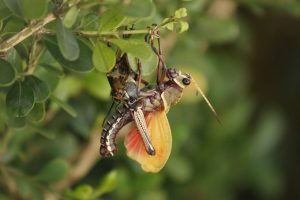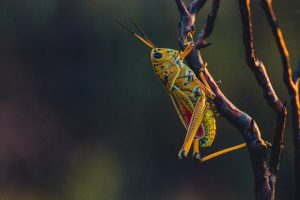Table of Contents
Cricket Life Cycle: From Egg to Adult
There are more than 900 species of crickets found across the globe, each with their own unique appearance. Despite their differences, the cricket life cycle is similar across all species.

Cricket
Crickets are found in a variety of colors ranging from brown, green, red or black depending on the species. Regardless of the species, every cricket passes through three developmental stages which include:
- eggs
- nymphs
- adults
Even though the developmental stages are similar, the time a cricket will spend in each stage can vary slightly between species.
The cricket life cycle is considered an incomplete metamorphosis because there is no pupal stage, and after hatching, cricket nymphs look just like adult crickets only smaller.
Mating
The distinct chirping sound crickets are famous for is actually male crickets trying to attract female crickets for mating. The sound is produced by their wings scraping together.
After mating females become fertile, and begin to search for a suitable place to lay their eggs. Usually they prefer to lay eggs in damp and humid places. Once they find an area with the right conditions they start laying eggs at a rapid pace. Females deposit their eggs with the help of their ovipositor, which is a tube-like organ.
——————-
A single female crickets can lay anywhere from 100 to 200 eggs in her lifetime.
——————-
• The Cricket Life Cycle •
Egg
The life of a cricket begins with an egg. After approximately 14 days the eggs will begin to hatch, and nymphs will start to break out of their shell. The nymphs then slowly dig out of the damp substrate they were lying in.

Cricket eggs by Forest & Kim Starr [CC BY 3.0 us]
Nymph
Nymphs are basically young versions of adult crickets. Even though they resemble adult crickets in appearance, they have a few differences:
- Upon hatching, nymphs are not developed as much as adults.
- Nymphs lack wings to fly.
- Female crickets are not sexually mature because they lack ovipositors, and thus are unable to reproduce.
- Sometimes nymphs don’t get enough time to develop into adults, and fall prey to bigger insects and adult crickets.
A nymph has to undergo molting to develop and grow into an adult. During this process they shed their hard exoskeleton, and develop a new one according to their growing body size. The new exoskeleton is initially soft, and a milky white color. Eventually it will harden in only a few hours. A nymph has to molt 8 – 10 times to fully develop into an adult, and usually takes a month to completely molt and start growing its wings.
Adult
The only requirement for a cricket to be categorized as an adult and fully mature are the development of wings. Once they have achieved this they pursue their life purposes, which is essentially eating and mating. Males will produce sounds to attract females for mating. Upon fertilization female crickets lay eggs, and the whole cricket life cycle begins again.

Cricket Lifespan
The lifespan of an adult cricket is around 6 weeks, while the life cycle usually takes 2 – 3 months to complete, depending upon outside conditions. The favorable temperature for crickets to thrive in is between 80°F – 90°F.
• Types of Baby Crickets •
Crickets are generally categorized into four main groups. Whether in urban or suburban surroundings the following types of crickets are the most common:
- Camel Crickets – These crickets are easy to identify because of their distinctive arched appearance which resembles a camel’s hump. They are incredible jumpers thanks to their long hind legs. Camel crickets are wingless, but they compensate for this with their long distance jumping. Usually found in dark areas like basements, garages, attics, crawl spaces, and storage areas.
- Field Crickets – Usually black or brown in color their distinctive feature is their long antennae, which are even longer than their body. As their name suggests field crickets love to live outdoors, and are usually found in lawns, near overgrown grass, flower beds, and bushes. Adults lay eggs in the soil which hatch in late spring, and fully develop by late summer.
- House Crickets – Just like field crickets, house crickets have very long antennae even longer than their body too. However, they are lighter in color with a yellowish brown color. You will usually find these crickets in dark spaces in homes, garages, attics, basements, and the backyard.
- Jerusalem Cricket – The distinct feature of Jerusalem crickets is their brown colored abdomen with black colored rings. They also have very large heads and legs, and are wingless too. Nymphs of Jerusalem Crickets usually molt up to 11 times for complete development to reach adulthood.

More Related Articles About Crickets:
